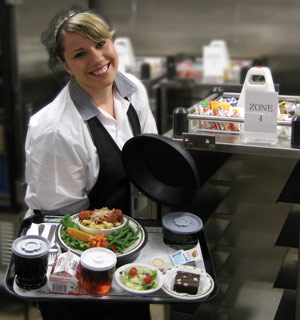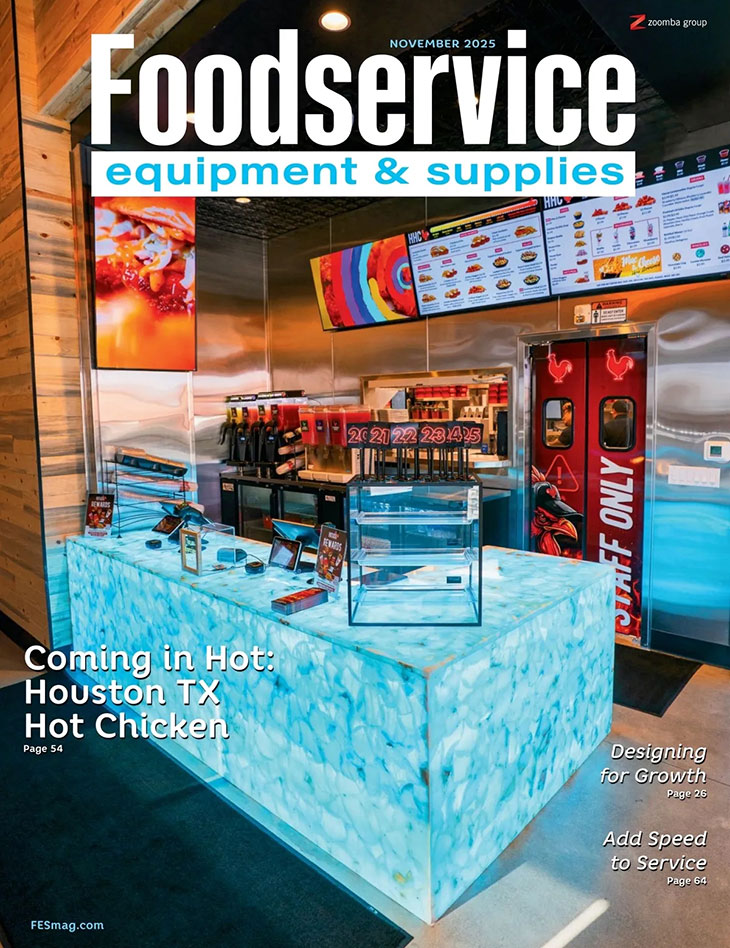More and more hospitals continue to implement hotel-style room service. For example, the nation opened its largest hotel-style hospital room service program in October 2011, at a 1,200-bed hospital in Florida.
 One of the largest contract foodservice providers in the United States told the hospital that this facility could not implement room service because there was not enough hood space and the hospital was too large. In spite of these concerns, the self-operated foodservice department transitioned to hotel-style room service in a smooth and effective manner. As a result, hospital executives are beaming with pride and patients are raving. This hospital was the first self-operated foodservice facility to utilize a precision temperature cooking model for food production.
One of the largest contract foodservice providers in the United States told the hospital that this facility could not implement room service because there was not enough hood space and the hospital was too large. In spite of these concerns, the self-operated foodservice department transitioned to hotel-style room service in a smooth and effective manner. As a result, hospital executives are beaming with pride and patients are raving. This hospital was the first self-operated foodservice facility to utilize a precision temperature cooking model for food production.
Last year, the 1,000-bed University of Alabama at Birmingham (UAB) Hospital became one of the largest health care facilities in the country to implement hotel-style room service. The UAB Hospital administration expects to save as much as $250,000 per year due to the transition to this style of service.
Even the Veterans Administration and its hospitals are cueing up for room service because executives are in possession of the facts about this style of service and continue to use them to bust myths and misconceptions that can accompany transforming a foodservice operation.
Foodservice directors who pioneered room service in hospitals naturally experienced some challenges because the industry lacked best practices for them to follow. Back then even consultants and architects didn’t know exactly how to design ideal hotel-style room service in a hospital. But times have changed and how to implement a successful room service program is no longer a mystery. In fact, some companies even specialize in hospital room service design, planning, readiness training and opening support. The process has been boiled down to a science with nothing left to chance.
As you might guess, we’re pretty passionate about room service in hospitals. So over the remainder of this article we’d like to answer a few of the common questions we hear when hospital foodservice operators consider transitioning to this style of service.

When applying the traditional hotel room service model in hospitals, the patients order what they want, when they want it, within dietary restrictions, from a fixed restaurant-style menu between the hours of 7 a.m. and 7 p.m. Some hospitals offer 24-hour room service. However, most hospitals are achieving high customer service scores without 24-hour service.
In an effort to modify their perception in the community, some hospitals may claim they have room service but in reality they have a modified or hybrid program. Operators should first strive for traditional hotel room service and only use hybrid models out of necessity.
Does room service cost more than other methods of delivering patient meals?
While many people may think this style of service costs more, we have found the opposite to be the case. It is paramount to conduct a thorough assessment that details all costs and savings derived from a well-designed program and that the facility follows through with the recommendations. When this happens, there is little chance that room service will cost more than traditional tray line meal service. This cost savings is how most hospitals pay back the room service start-up costs in less than two years, providing foodservice directors with the data they need to justify implementing this program in their facilities.
What percentage of hospitals now offer room service?
According to a survey done in 2008 by the National Society for Healthcare Foodservice Management (now Association for Healthcare Foodservice) 38 percent of hospitals that participated in the survey claimed that they had room service. Since this 2008 survey was done, hundreds more have implemented room service and the demand is growing.

Because times have changed. Patients now have higher expectations for customer service and that includes freshly made food with authentic flavor profiles and menus with customized options. Overall they want better food quality and presentation.
What are some of the benefits hospitals realize by adopting this style of service?
While every hospital is unique and elects to implement this style of service for their own reasons, here are a handful of benefits many hospitals realize when moving to room service.
Once designed and implemented correctly, customer satisfaction scores tend to skyrocket to the 90th to 99th percentile with the room service model. This tends to change the image of the hospital forever.
Generally, room service costs $100,000 less annually in food and supplies per 100 census. For example, an average census of 500 patients would save $500,000 per year in food and supplies.
Room service can improve hazard analysis and critical control points (HACCP) scores which can affect the government reimbursement hospitals receive for services rendered to patients.
Simply put, room service allows a hospital to enhance its competitive position by being more responsive to patient needs and wants.
Where should a hospital begin?
A typical room service assessment generally includes a 10-year ROI study, exact savings, staffing needs, equipment needs and costs, concept design and a presentation to administration. If there is an impediment to implementing room service, it will be discovered quickly and alternate hybrid methods should be immediately explored.
If researching and implanting a program of this nature does not fall within your comfort zone, consider working with a consultant that specializes in this area. Many organizations can take the foodservice director from research to presenting to hospital administration to implementation and training.
OK, so let’s say a hospital decides to take the plunge, how can a smooth transition be ensured?
In a 500-bed hospital, a room service support company may provide up to ten onsite chefs and dietitians for a week of 12-hour days. This intense start-up support takes the pain and risk out of the transition process. If hospital team members call in sick, your consultant support team should be able to fill in immediately to mitigate any delays in meal service during start-up.
Should I propose room service even though our hospital is in a cost-cutting posture?
Yes, because room service can often contribute to the overall hospital cost reduction process. It has been demonstrated to be the least expensive method of serving high quality meals.
To determine the exact costs and exact savings, conduct a feasibility study using the hospital’s internal historical data. This can help foodservice management and administrators learn how the room service model would affect the hospital financially. Some room service assessments have demonstrated millions of dollars in savings over 10 years. We have also seen hospitals break even, in a short period of time, after implementing room service.
Summary
Because true hotel room service can generate the highest customer satisfaction scores possible, it is recommended that hospitals first study the feasibility of implementing true hotel room service.
The only thing keeping many hospitals from implementing room service is accurate information. Research and experience in the field indicates that room service is generally the least expensive and the most environmentally friendly method for serving quality patient meals in a hospital.



